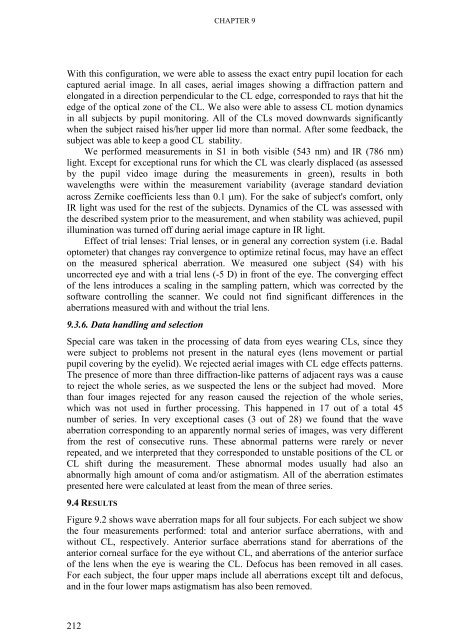Low_resolution_Thesis_CDD_221009_public - Visual Optics and ...
Low_resolution_Thesis_CDD_221009_public - Visual Optics and ...
Low_resolution_Thesis_CDD_221009_public - Visual Optics and ...
You also want an ePaper? Increase the reach of your titles
YUMPU automatically turns print PDFs into web optimized ePapers that Google loves.
CHAPTER 9<br />
With this configuration, we were able to assess the exact entry pupil location for each<br />
captured aerial image. In all cases, aerial images showing a diffraction pattern <strong>and</strong><br />
elongated in a direction perpendicular to the CL edge, corresponded to rays that hit the<br />
edge of the optical zone of the CL. We also were able to assess CL motion dynamics<br />
in all subjects by pupil monitoring. All of the CLs moved downwards significantly<br />
when the subject raised his/her upper lid more than normal. After some feedback, the<br />
subject was able to keep a good CL stability.<br />
We performed measurements in S1 in both visible (543 nm) <strong>and</strong> IR (786 nm)<br />
light. Except for exceptional runs for which the CL was clearly displaced (as assessed<br />
by the pupil video image during the measurements in green), results in both<br />
wavelengths were within the measurement variability (average st<strong>and</strong>ard deviation<br />
across Zernike coefficients less than 0.1 m). For the sake of subject's comfort, only<br />
IR light was used for the rest of the subjects. Dynamics of the CL was assessed with<br />
the described system prior to the measurement, <strong>and</strong> when stability was achieved, pupil<br />
illumination was turned off during aerial image capture in IR light.<br />
Effect of trial lenses: Trial lenses, or in general any correction system (i.e. Badal<br />
optometer) that changes ray convergence to optimize retinal focus, may have an effect<br />
on the measured spherical aberration. We measured one subject (S4) with his<br />
uncorrected eye <strong>and</strong> with a trial lens (-5 D) in front of the eye. The converging effect<br />
of the lens introduces a scaling in the sampling pattern, which was corrected by the<br />
software controlling the scanner. We could not find significant differences in the<br />
aberrations measured with <strong>and</strong> without the trial lens.<br />
9.3.6. Data h<strong>and</strong>ling <strong>and</strong> selection<br />
Special care was taken in the processing of data from eyes wearing CLs, since they<br />
were subject to problems not present in the natural eyes (lens movement or partial<br />
pupil covering by the eyelid). We rejected aerial images with CL edge effects patterns.<br />
The presence of more than three diffraction-like patterns of adjacent rays was a cause<br />
to reject the whole series, as we suspected the lens or the subject had moved. More<br />
than four images rejected for any reason caused the rejection of the whole series,<br />
which was not used in further processing. This happened in 17 out of a total 45<br />
number of series. In very exceptional cases (3 out of 28) we found that the wave<br />
aberration corresponding to an apparently normal series of images, was very different<br />
from the rest of consecutive runs. These abnormal patterns were rarely or never<br />
repeated, <strong>and</strong> we interpreted that they corresponded to unstable positions of the CL or<br />
CL shift during the measurement. These abnormal modes usually had also an<br />
abnormally high amount of coma <strong>and</strong>/or astigmatism. All of the aberration estimates<br />
presented here were calculated at least from the mean of three series.<br />
9.4 RESULTS<br />
Figure 9.2 shows wave aberration maps for all four subjects. For each subject we show<br />
the four measurements performed: total <strong>and</strong> anterior surface aberrations, with <strong>and</strong><br />
without CL, respectively. Anterior surface aberrations st<strong>and</strong> for aberrations of the<br />
anterior corneal surface for the eye without CL, <strong>and</strong> aberrations of the anterior surface<br />
of the lens when the eye is wearing the CL. Defocus has been removed in all cases.<br />
For each subject, the four upper maps include all aberrations except tilt <strong>and</strong> defocus,<br />
<strong>and</strong> in the four lower maps astigmatism has also been removed.<br />
212











